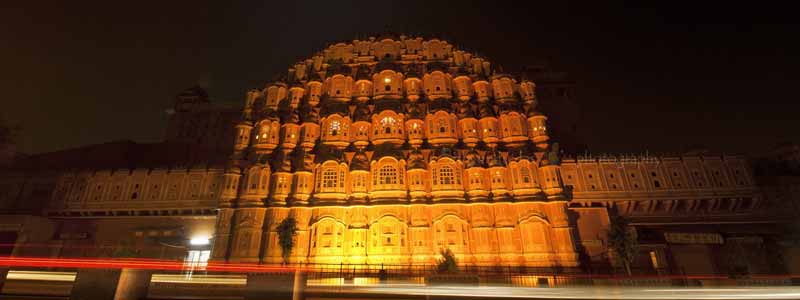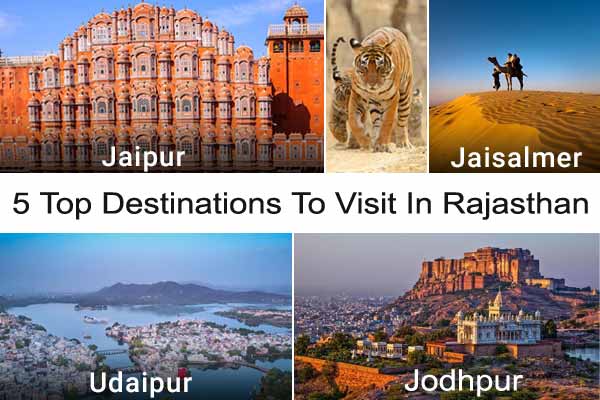5 Top Destinations To Visit In Rajasthan is located in the north-western region of India bordering Pakistan. This popular state of India is one of the most famous travel destinations for both international and domestic tourists. Culturally, Rajasthan is very significant because of its rich history and art. This destination is included in almost all popular Rajasthan tour packages available at various travel agencies.
With destinations located in the Thar desert to the ones located in Aravallis mountain range, both are equally popular among the tourists. Every year, this Indian state attracts thousands of tourists from all over the world to experience its unique heritage, its art, architecture and music. The land of Rajasthan is rooted in the history of its Rajput kings to whom many forts and monuments are dedicated.
Compared to all other states of India, Rajasthan has done a great job in promoting its culture through tourism and making it available to the world. Because of this Rajasthan has become a go-to destination for all people travelling to India. There are many places in Rajasthan that have been put on the world map as the best travel destinations with rich culture 5 Top Destinations To Visit In Rajasthan.

Jaipur – The Pink City
Founded in 1727 by Maharaj Jai Singh II, Jaipur’s present reeks of stories of the past. Famously known as the Pink City of the Rajasthan, it is not merely the largest and most prominent historical city of the state but also a city of love, covered with the aura of romantic hues and the warmth of pink skies. Home to a few UNESCO World Heritage sites, unparalleled natural and constructed beauty, regal architecture, royal cuisine, and always blooming with lively festivals and fairs, Jaipur, with its rich heritage, stands as the heart of the cultural epicentre of India.
Thus, no trip to Rajasthan can ever be complete without exploring the hidden beauty of Jaipur. Pink City stands as one of the 5 Top Destinations To Visit In Rajasthan.
The beautiful Hawa Mahal built with pink sandstones, the picturesque Jal Mahal, the architectural marvel of the City Palace, the geometric wonder of the Jantar Mantar Observatory, “the heaven piercing minaret” of Ishwar Lat, and the nostalgic aura of the Albert Hall Museum, make the aforementioned places the central attractions for tourists worldwide. With a variety of festivals, delicious cuisine, as well as culturally rich shopping markets, the city is also connected to other major cities in the state 5 Top Destinations To Visit In Rajasthan.
Highlights
- Enjoy the view of the Pink City through the 953 jharokhas (windows) of the Hawa Mahal or the Palace of Winds adorned with refined lattice-work. It is one of the best tourist places in Rajasthan.
- Savour the mouth-watering Pyaaz Kachori at Rawat Mishtan Bhandar.
- Cherish the renowned Bandhej textile art.
- Buy exotic jewellery at the Johari Bazaar.
- Participate in the annual Jaipur Literature Festival beaming with intellectual fervour.
Best Time to Visit Jaipur: October to March
Jaisalmer – The Golden City
Located in the north-western part of Rajasthan, Jaisalmer, the Golden city, is in the proximate ear short of Pakistan’s border. Adorned with the golden sand dunes and castles, Jaisalmer is a paradise of history, culture, and nature and this is one of the 5 Top Destinations To Visit In Rajasthan.
From enjoying the bird view of the city from the Jaisalmer Fort to the adventure of the thrilling desert safaris to the peace of Jain temples to the scenic marvel of the Desert National Park and the Gadisar Lake as well as to the strolls through the hustle-bustle of ancient markets, Jaisalmer will mark you with golden traces by exposing you to its hidden treasures.
Highlights
- Admire the golden view of the city from the Jaisalmer Fort, which is one of the best tourist places in Rajasthan.
- Explore the famous hand block printing art.
- Treasure the exquisite paintings and regal carpets at Sadar Bazzar.
- Enjoy the mouth-watering Jaisalmer Kala Chana Kadhi cuisine.
- Be a part of the annual Jaisalmer Desert Festival in the month of February.
Best Time to Visit Jaisalmer: October
Udaipur – The City of Lakes
Often attributed as the Venice of East and the Jewel of Mewar, the City of Lakes, Udaipur will leave you spellbound by its beauty and scenic wonders. From the architecture delights seen in forts, temples, as well as museums, to the serene watersides, Udaipur contains the soul of the state and is among the 5 Top Destinations To Visit In Rajasthan.
The profound City Palace, Lake Pichola, Ambrai Ghat, Sajjangarh Fort, King’s Vintage and Classic Car Museum, Shri Manshapurna Karni Mata temple, Gangaur Ghat, Bagore ki Haveli, and the trekking point at Badi Lake are some of the most visited places in Udaipur. It is also a storehouse of various lakeside cafes and restaurants that form a perfect romantic getaway or the ideal site to explore your solitude in the sublime bounty of nature.
Highlights
- You cannot miss out on the enthralling view of the City Palace from a boat ride on Lake Pichola.
- Have the irresistible Dal Poodi and Dal Baati at Manoj Prakash Daal Poodi stall.
- Buy the exquisite Pichwai and Phad paintings at Hathi Pol Bazaar.
- Explore the famous Bandhni Craft of Udaipur.
- Enjoy the dance procession in the Mewar Festival celebrated in April annually.
Best Time to Visit Udaipur: October to March
Jodhpur – The Blue City
Located on the edge of the great Thar Desert, Jodhpur is also famously known as the Sun City or the Blue City of Rajasthan. A hearth of sumptuous forts, palaces, lakes, as well as other beautiful retreats, it, however, has made an appearance in movies and magazine covers for its large number of blue-coloured houses that add just another shade to the diverse palette of Rajasthan. It is one of the 5 Top Destinations To Visit In Rajasthan.
Some of the famous places to visit in Jodhpur are Mehrangarh Fort, Khejarala Fort Umaid Bhawan Palace, Ghanta Ghar, Mangore Garden, Jaswant Thada, and Kalyana and Balsamand Lake. Jodhpur is also known for the Overlander desert safaris and Amal Sabha, a thousand-year-old traditional opium ceremony.
Highlights
- The ancient charm of the gigantic Mehrangarh Fort makes it one of the best tourist places in Rajasthan.
- The marvellous traditional textile printing at Jodhpur.
- The hustle-bustle of the Clock Tower Market.
- The tempting Lal Maas at Darikhana, Raas Haveli.
- The vibrant Maand Festival held annually in October.
Best Time to Visit Jodhpur: November to February
Ranthambore
A visit to Ranthambore will give you a glimpse into the rich biodiversity that the magnificent state of Rajasthan has in its store. Most famous for its tiger reserve and jeep safaris, the Ranthambore National Reserve is a delight for patient animal lovers and bird watchers. It is one of the 5 Top Destinations To Visit In Rajasthan.
The Ranthambore Fort, a UNESCO World Heritage Site, situated inside the trinetra Ganesh temple, is visited by history enthusiasts and religious devotees throughout the year. With various other picturesque sites such as Padam Lake, Jogi Mahal, and Kacheeda Valley, Ranthambore is a delight for nature and beauty lovers.
Highlights
- The enamouring sightseeing of the mighty Royal Tigers, Sloth Bears, Leopards, as well as crocodiles at the Ranthambore National Reserve.
- The must-have churma ladoo among other sweet delicacies at the Oberoi Vanyavilas.
- The rural handicrafts available at the Village Women Craft House.
- The exuberant Ranthambore Music and Wildlife Festival held at Nahargarh Palace in the month of December every year.
Best Time to Visit Ranthambore: October to April
